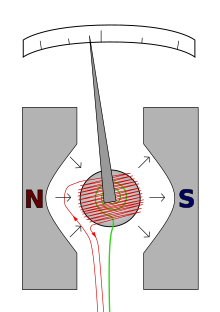Demonstration Analog Voltmeter
From Wikipedia, the free reference book
Hop to navigationJump to look
This article is about Voltmeter. It isn't to be mistaken for Voltameter.
Showing simple voltmeter
A voltmeter is an instrument utilized for estimating electrical potential distinction between two out of an electric circuit. Simple voltmeters move a pointer over a scale in relation to the voltage of the circuit; advanced voltmeters give a numerical showcase of voltage by utilization of a simple to computerized converter.

A voltmeter in a circuit graph is spoken to by the letter V around.
Voltmeters are made in a wide scope of styles. Instruments forever mounted in a board are utilized to screen generators or other fixed mechanical assembly. Versatile instruments, typically prepared to likewise quantify flow and obstruction as a multimeter, are standard test instruments utilized in electrical and hardware work. Any estimation that can be changed over to a voltage can be shown on a meter that is reasonably adjusted; for instance, pressure, temperature, stream or level in a substance procedure plant.
Explain
Broadly useful simple voltmeters may have a precision of a couple of percent of full scale, and are utilized with voltages from a small amount of a volt to a few thousand volts. Advanced meters can be made with high exactness, ordinarily superior to 1%. Exceptionally aligned test instruments have higher exactnesses, with research center instruments equipped for estimating to correctnesses of a couple of parts for each million. Meters utilizing enhancers can quantify small voltages of microvolts or less.
Some portion of the issue of making an exact voltmeter is that of adjustment to check its exactness. In research facilities, the Weston Cell is utilized as a standard voltage for exactness work. Accuracy voltage references are accessible dependent on electronic circuits.
Analog Voltmeter
A moving curl galvanometer can be utilized as a voltmeter by embeddings a resistor in arrangement with the instrument. The galvanometer has a loop of fine wire suspended in a solid attractive field. At the point when an electric flow is applied, the communication of the attractive field of the loop and of the stationary magnet makes a torque, tending to cause the curl to pivot. The torque is relative to the current through the loop. The loop pivots, compacting a spring that restricts the revolution. The redirection of the loop is in this way relative to the current, which thusly is corresponding to the applied voltage, which is shown by a pointer on a scale.
Explain
 One of the structure targets of the instrument is to upset the circuit as meager as could reasonably be expected thus the instrument should draw at least current to work. This is accomplished by utilizing a delicate galvanometer in arrangement with a high obstruction, and afterward the whole instrument is associated in parallel with the circuit inspected.
One of the structure targets of the instrument is to upset the circuit as meager as could reasonably be expected thus the instrument should draw at least current to work. This is accomplished by utilizing a delicate galvanometer in arrangement with a high obstruction, and afterward the whole instrument is associated in parallel with the circuit inspected. Affectability
The affectability of such a meter can be communicated as "ohms per volt", the quantity of ohms obstruction in the meter circuit isolated by the full scale estimated esteem. For instance, a meter with an affectability of 1000 ohms for every volt would draw 1 milliampere at full scale voltage; if the full scale was 200 volts, the opposition at the instrument's terminals would be 200000 ohms and at full scale the meter would draw 1 milliampere from the circuit under test. For multi-run instruments, the info opposition fluctuates as the instrument is changed to various extents.
Moving-curl instruments with a lasting magnet field react just to coordinate current. Estimation of AC voltage requires a rectifier in the circuit with the goal that the loop redirects in just a single heading. Some moving-loop instruments are additionally made with the zero position in the scale rather than toward one side; these are helpful if the voltage switches its extremity.
Voltmeters
Voltmeters working on the electrostatic rule utilize the common shock between two charged plates to divert a pointer appended to a spring. Meters of this sort draw unimportant current however are delicate to voltages over around 100 volts and work with either substituting or direct current.



0 Comments